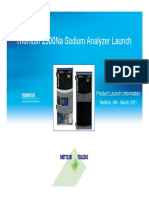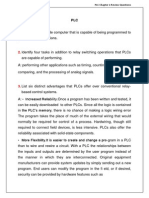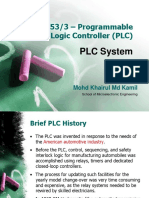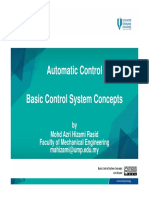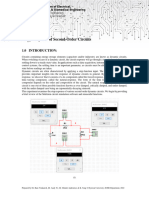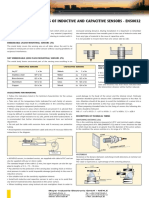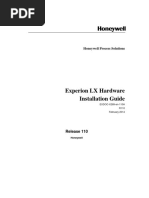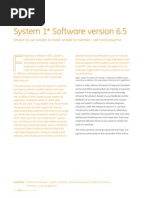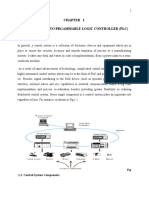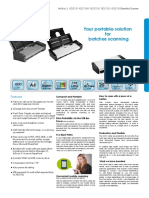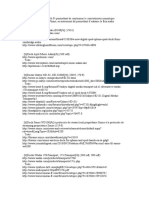ch-1 Petruzella PDF
ch-1 Petruzella PDF
Uploaded by
ozzaapriodedeCopyright:
Available Formats
ch-1 Petruzella PDF
ch-1 Petruzella PDF
Uploaded by
ozzaapriodedeOriginal Title
Copyright
Available Formats
Share this document
Did you find this document useful?
Is this content inappropriate?
Copyright:
Available Formats
ch-1 Petruzella PDF
ch-1 Petruzella PDF
Uploaded by
ozzaapriodedeCopyright:
Available Formats
1
Programmable Logic
Controllers (PLCs)
An Overview
Image Used with Permission of Rockwell Automation, Inc.
Chapter Objectives
After completing this chapter, you will be able to: This chapter gives a brief history of the evolution
1.1 Define what a programmable logic controller (PLC) is of the programmable logic controller, or PLC.
and list its advantages over relay systems The reasons for changing from relay control sys-
1.2 Identify the main parts of a PLC and describe their tems to PLCs are discussed. You will learn the
functions basic parts of a PLC, how a PLC is used to con-
1.3 Outline the basic sequence of operation for a PLC trol a process, and the different kinds of PLCs
1.4 Identify the general classifications of PLCs and their applications. The ladder logic language,
which was developed to simplify the task of pro-
gramming PLCs, is introduced.
pet10882_ch01_001-016.indd 1 7/23/10 9:00 PM
1.1 Programmable Logic Controllers Programmable controllers offer several advantages
over a conventional relay type of control. Relays have to
Programmable logic controllers (Figure 1-1) are now the be hardwired to perform a specific function. When the
most widely used industrial process control technology. system requirements change, the relay wiring has to be
A programmable logic controller (PLC) is an industrial changed or modified. In extreme cases, such as in the auto
grade computer that is capable of being programmed to industry, complete control panels had to be replaced since
perform control functions. The programmable controller it was not economically feasible to rewire the old panels
has eliminated much of the hardwiring associated with with each model changeover. The programmable control-
conventional relay control circuits. Other benefits include ler has eliminated much of the hardwiring associated with
easy programming and installation, high control speed, conventional relay control circuits (Figure 1-2). It is small
network compatibility, troubleshooting and testing conve- and inexpensive compared to equivalent relay-based pro-
nience, and high reliability. cess control systems. Modern control systems still include
The programmable logic controller is designed for relays, but these are rarely used for logic.
multiple input and output arrangements, extended tem- In addition to cost savings, PLCs provide many other
perature ranges, immunity to electrical noise, and resis- benefits including:
tance to vibration and impact. Programs for the control
and operation of manufacturing process equipment and Increased Reliability. Once a program has been
machinery are typically stored in battery-backed or non- written and tested, it can be easily downloaded
volatile memory. A PLC is an example of a real-time sys- to other PLCs. Since all the logic is contained in
tem since the output of the system controlled by the PLC the PLCs memory, there is no chance of making
depends on the input conditions. a logic wiring error (Figure 1-3). The program
The programmable logic controller is, then, basically takes the place of much of the external wiring that
a digital computer designed for use in machine control. would normally be required for control of a process.
Unlike a personal computer, it has been designed to op- Hardwiring, though still required to connect field
erate in the industrial environment and is equipped with devices, is less intensive. PLCs also offer the
special input/output interfaces and a control programming reliability associated with solid-state components.
language. The common abbreviation used in industry for More Flexibility. It is easier to create and change a pro-
these devices, PC, can be confusing because it is also the gram in a PLC than to wire and rewire a circuit. With a
abbreviation for personal computer. Therefore, most PLC the relationships between the inputs and outputs
manufacturers refer to their programmable controller as a are determined by the user program instead of the
PLC, which stands for programmable logic controller. manner in which they are interconnected (Figure1-4).
Initially the PLC was used to replace relay logic, but its Original equipment manufacturers can provide system
ever-increasing range of functions means that it is found in updates by simply sending out a new program. End
many and more complex applications. Because the struc- users can modify the program in the field, or if desired,
ture of a PLC is based on the same principles as those security can be provided by hardware features such as
employed in computer architecture, it is capable not only key locks and by software passwords.
of performing relay switching tasks but also of performing Lower Cost. PLCs were originally designed to re-
other applications such as timing, counting, calculating, place relay control logic, and the cost savings have
comparing, and the processing of analog signals. been so significant that relay control is becoming
(a) (b)
Figure 1-1 Programmable logic controller.
Source: (ab) Courtesy GE Intelligent Platforms.
2 Chapter 1 Programmable Logic Controllers (PLCs)
pet10882_ch01_001-016.indd 2 7/23/10 9:00 PM
PLC
User program
Figure 1-3 All the logic is contained in the PLCs memory.
Contactor Light Solenoid
Outputs
(a)
Inputs
Pushbutton Limit switch Sensor
(b) Figure 1-4 Relationships between the inputs and outputs
Figure 1-2 Relay- and PLC-based control panels. (a) Relay- are determined by the user program.
based control panel. (b) PLC-based control panel.
Source: (a) Courtesy Mid-Illini Technical Group, Inc.; (b) Photo courtesy Ramco
Electric, Ltd. Faster Response Time. PLCs are designed for high-
speed and real-time applications (Figure 1-6). The
obsolete except for power applications. Generally, programmable controller operates in real time,
if an application has more than about a half-dozen which means that an event taking place in the
control relays, it will probably be less expensive to field will result in the execution of an operation or
install a PLC. output. Machines that process thousands of items
Communications Capability. A PLC can communi- persecond and objects that spend only a fraction
cate with other controllers or computer equipment to of a second in front of a sensor require the PLCs
perform such functions as supervisory control, data quick-response capability.
gathering, monitoring devices and process parameters, Easier to Troubleshoot. PLCs have resident diag-
and download and upload of programs (Figure 1-5). nostics and override functions that allow users to
Programmable Logic Controllers (PLCs) Chapter 1 3
pet10882_ch01_001-016.indd 3 7/23/10 9:00 PM
1.2 Parts of a PLC
A typical PLC can be divided into parts, as illustrated in
Figure 1-8. These are the central processing unit (CPU),
the input/output (I/O) section, the power supply, and the
programming device. The term architecture can refer to
PLC hardware, to PLC software, or to a combination of
both. An open architecture design allows the system to be
connected easily to devices and programs made by other
manufacturers. Open architectures use off-the-shelf com-
ponents that conform to approved standards. A system
with a closed architecture is one whose design is propri-
etary, making it more difficult to connect to other systems.
Most PLC systems are in fact proprietary, so you must be
sure that any generic hardware or software you may use
is compatible with your particular PLC. Also, although
Figure 1-5 PLC communication module. the principal concepts are the same in all methods of pro-
Source: Photo courtesy Automation Direct, www.automationdirect.com.
gramming, there might be slight differences in address-
ing, memory allocation, retrieval, and data handling for
different models. Consequently, PLC programs cannot be
interchanged among different PLC manufacturers.
There are two ways in which I/Os (Inputs/Outputs) are
incorporated into the PLC: fixed and modular. Fixed I/O
(Figure 1-9) is typical of small PLCs that come in one
package with no separate, removable units. The processor
and I/O are packaged together, and the I/O terminals will
have a fixed number of connections built in for inputs and
outputs. The main advantage of this type of packaging is
lower cost. The number of available I/O points varies and
usually can be expanded by buying additional units of
fixed I/O. One disadvantage of fixed I/O is its lack of flex-
ibility; you are limited in what you can get in the quanti-
Figure 1-6 High-speed counting. ties and types dictated by the packaging. Also, for some
Source: Courtesy Banner Engineering Corp.
models, if any part in the unit fails, the whole unit has to
be replaced.
PLC Monitor
Modular I/O (Figure 1-10) is divided by compartments
into which separate modules can be plugged. This fea-
ture greatly increases your options and the units flexibil-
ity. You can choose from the modules available from the
manufacturer and mix them any way you desire. The basic
modular controller consists of a rack, power supply, pro-
cessor module (CPU), input/output (I/O modules), and an
operator interface for programming and monitoring. The
modules plug into a rack. When a module is slid into the
rack, it makes an electrical connection with a series of con-
Figure 1-7 Control program can be displayed on a monitor tacts called the backplane, located at the rear of the rack.
in real time. The PLC processor is also connected to the backplane and
can communicate with all the modules in the rack.
easily trace and correct software and hardware prob- The power supply supplies DC power to other modules
lems. To find and fix problems, users can display the that plug into the rack (Figure 1-11). For large PLC systems,
control program on a monitor and watch it in real this power supply does not normally supply power to the
time as it executes (Figure 1-7). field devices. With larger systems, power to field devices is
4 Chapter 1 Programmable Logic Controllers (PLCs)
pet10882_ch01_001-016.indd 4 7/27/10 9:58 PM
Input Power supply
Output
module module
module
Processor Module
Input Central
sensing Processing M Output
devices Unit (CPU) load
devices
Memory
Program Data
Optical Optical
isolation isolation
Programming device
(a) Modular type
Power supply
CPU
Input Output
Memory
section section
Communications
(b) Fixed type
Figure 1-8 Typical parts of a programmable logic controller.
Source: (a) Courtesy Mitsubishi Automation; (b) Image Used with Permission of Rockwell Automation, Inc.
Common power bus
provided by external alternating current (AC) or direct cur-
rent (DC) supplies. For some small micro PLC systems, the
power supply may be used to power field devices.
The processor (CPU) is the brain of the PLC. A typi-
cal processor (Figure 1-12) usually consists of a micro-
processor for implementing the logic and controlling the
Input
communications among the modules. The processor re-
connections quires memory for storing the results of the logical op-
erations performed by the microprocessor. Memory is also
Processor PLC
required for the program EPROM or EEPROM plus RAM.
Output The CPU controls all PLC activity and is designed so
connections that the user can enter the desired program in relay ladder
logic. The PLC program is executed as part of a repeti-
tive process referred to as a scan (Figure 1-13). A typical
PL PLC scan starts with the CPU reading the status of inputs.
Then, the application program is executed. Once the pro-
gram execution is completed, the CPU performs internal
diagnostic and communication tasks. Next, the status of
Common return bus
all outputs is updated. This process is repeated continu-
Figure 1-9 Fixed I/O conguration. ously as long as the PLC is in the run mode.
Programmable Logic Controllers (PLCs) Chapter 1 5
pet10882_ch01_001-016.indd 5 7/27/10 9:58 PM
Processor Combination
module I/O module
Power
supply
Input module Output module
Figure 1-12 Typical PLC processor modules.
Source: Image Used with Permission of Rockwell Automation, Inc.
uts Ex
inp ec
ad u
Re
te
pr
og
ram
Upd
ate
ca s &
Module
n
tio
st
ic
ou
slides into tp
uts
gno ni
the rack Dia mu
com
Figure 1-10 Modular I/O conguration.
Figure 1-13 Typical PLC scan cycle.
The I/O system forms the interface by which field de-
vices are connected to the controller (Figure 1-14). The
purpose of this interface is to condition the various sig-
nals received from or sent to external field devices. Input
devices such as pushbuttons, limit switches, and sensors
are hardwired to the input terminals. Output devices such
as small motors, motor starters, solenoid valves, and in-
dicator lights are hardwired to the output terminals. To
electrically isolate the internal components from the
input and output terminals, PLCs commonly employ an
optical isolator, which uses light to couple the circuits to-
gether. The external devices are also referred to as field
Power supply or real-world inputs and outputs. The terms field or
real world are used to distinguish actual external devices
Figure 1-11 The power supply supplies DC power to other
modules that plug into the rack. that exist and must be physically wired from the internal
Source: This material and associated copyrights are proprietary to, and used user program that duplicates the function of relays, tim-
with the permission of Schneider Electric. ers, and counters.
6 Chapter 1 Programmable Logic Controllers (PLCs)
pet10882_ch01_001-016.indd 6 7/23/10 9:01 PM
Input module Output module
0 4 8 12 24 VDC 0 4 8 12 240 VAC
1 5 9 13 input 1 5 9 13 output
2 6 10 14 module 2 6 10 14 module
Field device
3 7 11 15 power supply 3 7 11 15
L2 L1
240 VAC
IN 0 VAC
IN 1 OUT 0
IN 2 M OUT 1
IN 3 OUT 2
IN 4 OUT 3
IN 5 OUT 4
IN 6 OUT 5
IN 7 OUT 6
IN 8 OUT 7
IN 9 OUT 8
IN 10 R OUT 9
IN 11 OUT 10
IN 12 OUT 11
IN 13 OUT 12
IN 14 Y OUT 13
IN 15 OUT 14
DC
OUT 15
+ 24 VDC COM DC AC
COM COM
Field device
power supply
Figure 1-14 Typical PLC input/output (I/O) system connections.
A programming device is used to enter the desired pro-
gram into the memory of the processor. The program can
be entered using relay ladder logic, which is one of the
most popular programming languages. Instead of words,
ladder logic programming language uses graphic symbols
that show their intended outcome. A program in ladder
logic is similar to a schematic for a relay control circuit.
It is a special language written to make it easy for peo-
ple familiar with relay logic control to program the PLC.
Hand-held programming devices (Figure 1-15) are some-
times used to program small PLCs because they are inex-
pensive and easy to use. Once plugged into the PLC, they
can be used to enter and monitor programs. Both compact
hand-held units and laptop computers are frequently used
on the factory floor for troubleshooting equipment, modi-
Figure 1-15 Typical hand-held programming device.
fying programs, and transferring programs to multiple
Source: Photo courtesy Automation Direct, www.automationdirect.com.
machines.
A personal computer (PC) is the most commonly used
programming device. Most brands of PLCs have software
available so that a PC can be used as the programming the programming unit is not in use, it may be unplugged
device. This software allows users to create, edit, docu- and removed. Removing the programming unit will not
ment, store, and troubleshoot ladder logic programs (Fig- affect the operation of the user program.
ure 1-16). The computer monitor is able to display more A program is a user-developed series of instructions
logic on the screen than can hand-held types, thus sim- that directs the PLC to execute actions. A programming
plifying the interpretation of the program. The personal language provides rules for combining the instructions
computer communicates with the PLC processor via a se- so that they produce the desired actions. Relay ladder
rial or parallel data communications link, or Ethernet. If logic (RLL) is the standard programming language used
Programmable Logic Controllers (PLCs) Chapter 1 7
pet10882_ch01_001-016.indd 7 7/23/10 9:01 PM
Figure 1-16 Typical PC software used to create a ladder logic program.
Source: Image Used with Permission of Rockwell Automation, Inc.
with PLCs. Its origin is based on electromechanical relay
control. The relay ladder logic program graphically rep- Motor
resents rungs of contacts, coils, and special instruction
blocks. RLL was originally designed for easy use and un-
derstanding for its users and has been modified to keep up
with the increasing demands of industrys control needs.
Pressure
sensor
switch
1.3 Principles of Operation
To get an idea of how a PLC operates, consider the simple Temperature
sensor switch
process control problem illustrated in Figure 1-17. Here a
mixer motor is to be used to automatically stir the liquid
in a vat when the temperature and pressure reach preset
values. In addition, direct manual operation of the motor
is provided by means of a separate pushbutton station. Manual pushbutton station
The process is monitored with temperature and pressure
sensor switches that close their respective contacts when Figure 1-17 Mixer process control problem.
conditions reach their preset values.
This control problem can be solved using the relay appropriate input module according to the manufacturers
method for motor control shown in the relay ladder dia- addressing location scheme. Typical wiring connections
gram of Figure 1-18. The motor starter coil (M) is energized for a 120 VAC modular configured input module is shown
when both the pressure and temperature switches are closed in Figure 1-19.
or when the manual pushbutton is pressed. The same output field device (motor starter coil) would
Now lets look at how a programmable logic controller also be used. This device would be hardwired to an appropri-
might be used for this application. The same input field ate output module according to the manufacturers addressing
devices (pressure switch, temperature switch, and push- location scheme. Typical wiring connections for a 120 VAC
button) are used. These devices would be hardwired to an modular configured output module is shown in Figure 1-20.
8 Chapter 1 Programmable Logic Controllers (PLCs)
pet10882_ch01_001-016.indd 8 7/23/10 9:01 PM
L1 L2
Output
120 VAC module L1 N
120 VAC
Pressure Temperature
switch switch OL
M
L1
Motor 0
starter OL
coil 1 M
2 Motor
3 starter coil
Manual
pushbutton 4
5
Figure 1-18 Process control relay ladder diagram.
6
7
Input
Figure 1-20 Typical wiring connections for a 120 VAC
module
modular congured output module.
Source: Photo courtesy Automation Direct, www.automationdirect.com.
Pressure
Temperature
For the program to operate, the controller is placed
1
2 in the RUN mode, or operating cycle. During each op-
erating cycle, the controller examines the status of input
3 devices, executes the user program, and changes outputs
4
accordingly. Each symbol can be thought of as a set of
5
Manual
normally open contacts. The symbol is considered to
6
pushbutton represent a coil that, when energized, will close a set of
7
contacts. In the ladder logic program of Figure 1-21, the
coil O/1 is energized when contacts I/1 and I/2 are closed
L1 N
120 VAC Common
or when contact I/3 is closed. Either of these conditions
provides a continuous logic path from left to right across
Figure 1-19 Typical wiring connections for a 120 VAC the rung that includes the coil.
modular congured input module. A programmable logic controller operates in real time
Source: Photo courtesy Automation Direct, www.automationdirect.com. in that an event taking place in the field will result in an
operation or output taking place. The RUN operation for
the process control scheme can be described by the fol-
Next, the PLC ladder logic program would be con- lowing sequence of events:
structed and entered into the memory of the CPU. A First, the pressure switch, temperature switch, and
typical ladder logic program for this process is shown in pushbutton inputs are examined and their status is
Figure 1-21. The format used is similar to the layout of recorded in the controllers memory.
the hardwired relay ladder circuit. The individual symbols
A closed contact is recorded in memory as logic 1
represent instructions, whereas the numbers represent the
and an open contact as logic 0.
instruction location addresses. To program the controller,
you enter these instructions one by one into the proces- Next the ladder diagram is evaluated, with each
sor memory from the programming device. Each input internal contact given an OPEN or CLOSED status
and output device is given an address, which lets the PLC according to its recorded 1 or 0 state.
know where it is physically connected. Note that the I/O When the states of the input contacts provide logic
address format will differ, depending on the PLC model continuity from left to right across the rung, the
and manufacturer. Instructions are stored in the user pro- output coil memory location is given a logic 1 value
gram portion of the processor memory. During the pro- and the output module interface contacts will close.
gram scan the controller monitors the inputs, executes the When there is no logic continuity of the program
control program, and changes the output accordingly. rung, the output coil memory location is set to logic0
Programmable Logic Controllers (PLCs) Chapter 1 9
pet10882_ch01_001-016.indd 9 7/23/10 9:01 PM
Inputs Program Output
Motor
L1 Pressure Temperature starter L2
I/1 switch switch coil
I/1 I/2 O/1 OL
O/1 M
I/2 Manual
pushbutton
I/3
I/3
Monitor ...Checks the
inputs inputs
Execute ...Executes control
program program
Change ...And updates the
outputs outputs
Figure 1-21 Process control PLC ladder logic program with typical addressing scheme.
L1
Pressure
PB
L2
Temp
L1 L2 I1 I2 I3
Inputs
I1 I2 Q1
I3
Program
Outputs
Q1 Q2 Q3 Q4
M Starter
Figure 1-22 Typical wiring required to implement the process control scheme
using a xed PLC controller.
Source: Image Used with Permission of Rockwell Automation, Inc.
and the output module interface contacts will be Generally, the output memory location is updated
open. during the scan but the actual output is not
The completion of one cycle of this sequence by the updateduntil the end of the program scan during
controller is called a scan. The scan time, the time theI/O scan.
required for one full cycle, provides a measure of Figure 1-22 shows the typical wiring required to im-
the speed of response of the PLC. plement the process control scheme using a fixed PLC
10 Chapter 1 Programmable Logic Controllers (PLCs)
pet10882_ch01_001-016.indd 10 7/23/10 9:01 PM
controller. In this example the Allen-Bradley Pico con- Motor
troller equipped with 8 inputs and 4 outputs is used to Pressure Temperature starter
switch switch coil
control and monitor the process. Installation can be sum- I/1 I/2 O/1
marized as follows:
Fused power lines, of the specified voltage type and
level, are connected to the controllers L1 and L2 Manual
pushbutton
terminals. I/3
The pressure switch, temperature switch, and push-
button field input devices are hardwired between
L1 and controller input terminals I1, I2, and I3,
respectively. Figure 1-24 PLC ladder logic program for the modied
The motor starter coil connects directly to L2 and in process.
series with Q1 relay output contacts to L1.
The ladder logic program is entered using the front
keypad and LCD display.
Pico programming software is also available that
1.5 PLCs versus Computers
allows you to create as well as test your program
using a personal computer. The architecture of a PLC is basically the same as that
of a personal computer. A personal computer (PC) can
be made to operate as a programmable logic control-
1.4 Modifying the Operation ler if you provide some way for the computer to re-
ceive information from devices such as pushbuttons
One of the important features of a PLC is the ease with
or switches. You also need a program to process the
which the program can be changed. For example, assume
inputs and decide the means of turning load devices
that the original process control circuit for the mixing op-
off and on.
eration must be modified as shown in the relay ladder dia-
However, some important characteristics distinguish
gram of Figure 1-23. The change requires that the manual
PLCs from personal computers. First, unlike PCs, the
pushbutton control be permitted to operate at any pres-
PLC is designed to operate in the industrial environ-
sure, but not unless the specified temperature setting has
ment with wide ranges of ambient temperature and
been reached.
humidity. A well-designed industrial PLC installation,
If a relay system were used, it would require some re-
such as that shown in Figure 1-25, is not usually af-
wiring of the circuit shown in Figure 1-23 to achieve the
fected by the electrical noise inherent in most industrial
desired change. However, if a PLC system were used, no
locations.
rewiring would be necessary. The inputs and outputs are
Unlike the personal computer, the PLC is programmed
still the same. All that is required is to change the PLC
in relay ladder logic or other easily learned languages.
ladder logic program as shown in Figure 1-24.
The PLC comes with its program language built into its
memory and has no permanently attached keyboard, CD
drive, or monitor. Instead, PLCs come equipped with ter-
L1 L2 minals for input and output field devices as well as com-
120 VAC munication ports.
Computers are complex computing machines capable
Pressure Temperature
switch switch OL of executing several programs or tasks simultaneously
M and in any order. Most PLCs, on the other hand, execute a
Motor single program in an orderly and sequential fashion from
starter first to last instruction.
coil
PLC control systems have been designed to be easily
installed and maintained. Troubleshooting is simplified
Manual by the use of fault indicators and messaging displayed
pushbutton
on the programmer screen. Input/output modules for
Figure 1-23 Relay ladder diagram for the modied connecting the field devices are easily connected and
process. replaced.
Programmable Logic Controllers (PLCs) Chapter 1 11
pet10882_ch01_001-016.indd 11 7/23/10 9:01 PM
Figure 1-26 PLC operator interface and monitor.
Source: Courtesy Rogers Machinery Company, Inc.
(a)
(b)
Figure 1-25 PLC installed in an industrial environment. Figure 1-27 Programmable automation controller (PAC).
Source: (ab) Courtesy Automation IG. Source: Photo courtesy Omron Industrial Automation, www.ia.omron.com.
Software associated with a PLC but written and run on by blending the advantages of PLC-style control with
a personal computer falls into the following two broad that of PC-based systems. Such a device has been termed
categories: a programmable automation controller, or PAC (Fig-
PLC software that allows the user to program and ure1-27). Programmable automation controllers combine
document gives the user the tools to write a PLC PLC ruggedness with PC functionality. Using PACs, you
programusing ladder logic or another program- can build advanced systems incorporating software capa-
ming languageand document or explain the bilities such as advanced control, communication, data
program in as much detail as is necessary. logging, and signal processing with rugged hardware per-
forming logic, motion, process control, and vision.
PLC software that allows the user to monitor
and control the process is also called a human
machine interface (HMI). It enables the user to 1.6 PLC Size and Application
view a processor a graphical representation of a
The criteria used in categorizing PLCs include functional-
processon a monitor, determine how the system
ity, number of inputs and outputs, cost, and physical size
is running, trend values, and receive alarm condi-
(Figure 1-28). Of these, the I/O count is the most impor-
tions (Figure1-26). Many operator interfaces do
tant factor. In general, the nano is the smallest size with
not use PLC software. PLCs can be integrated with
less than 15 I/O points. This is followed by micro types
HMIs but the same software does not program both
(15 to 128 I/O points), medium types (128 to 512 I/O
devices.
points), and large types (over 512 I/O points).
Most recently automation manufacturers have responded Matching the PLC with the application is a key factor
to the increased requirements of industrial control systems in the selection process. In general it is not advisable to
12 Chapter 1 Programmable Logic Controllers (PLCs)
pet10882_ch01_001-016.indd 12 7/23/10 9:01 PM
Figure 1-29 Single-ended PLC application.
Source: Courtesy Rogers Machinery Company, Inc.
Figure 1-28 Typical range of sizes of programmable
controllers.
Source: Courtesy Siemens. of application requires a large PLC processor designed to
communicate with other PLCs and possibly with a com-
puter. The control management PLC supervises several
buy a PLC system that is larger than current needs dic- PLCs by downloading programs that tell the other PLCs
tate. However, future conditions should be anticipated to what has to be done. It must be capable of connection to
ensure that the system is the proper size to fill the current all the PLCs so that by proper addressing it can communi-
and possibly future requirements of an application. cate with any one it wishes to.
There are three major types of PLC application: single- Memory is the part of a PLC that stores data, instruc-
ended, multitask, and control management. A single- tions, and the control program. Memory size is usually
ended or stand-alone PLC application involves one PLC expressed in K values: 1 K, 6 K, 12 K, and so on. The
controlling one process (Figure 1-29). This would be a measurement kilo, abbreviated K, normally refers to
stand-alone unit and would not be used for communicat- 1000units. When dealing with computer or PLC memory,
ing with other computers or PLCs. The size and sophisti- however, 1 K means 1024, because this measurement is
cation of the process being controlled are obvious factors based on the binary number system (210 = 1024). Depend-
in determining which PLC to select. The applications ing on memory type, 1 K can mean 1024 bits, 1024 bytes,
could dictate a large processor, but usually this category or 1024words.
requires a small PLC. Although it is common for us to measure the memory
A multitask PLC application involves one PLC control- capacity of PLCs in words, we need to know the num-
ling several processes. Adequate I/O capacity is a signifi- ber of bits in each word before memory size can be accu-
cant factor in this type of installation. In addition, if the PLC rately compared. Modern computers usually have a word
would be a subsystem of a larger process and would have to size of 16, 32, or 64 bits. For example, a PLC that uses
communicate with a central PLC or computer, provisions 8-bit words has 49,152 bits of storage with a 6 K word
for a data communications network are also required. capacity (8 3 6 3 1024 5 49,152), whereas a PLC using
A control management PLC application involves one 32-bit words has 196,608 bits of storage with the same
PLC controlling several others (Figure 1-30). This kind 6 K memory (32 3 6 3 1024 5 196,608). The amount
Figure 1-30 Control management PLC application.
Programmable Logic Controllers (PLCs) Chapter 1 13
pet10882_ch01_001-016.indd 13 7/23/10 9:02 PM
Table 1-1 Typical PLC Instructions
Instruction Operation
XIC (Examine ON) . . . . . . . . . . . . Examine a bit for an ON condition
XIO (Examine OFF) . . . . . . . . . . . Examine a bit for an OFF condition
OTE (Output Energize) . . . . . . . . . Turn ON a bit (nonretentive)
OTL (Output Latch) . . . . . . . . . . . Latch a bit (retentive)
OTU (Output Unlatch) . . . . . . . . . Unlatch a bit (retentive)
TOF (Timer Off-Delay) . . . . . . . . . Turn an output ON or OFF after its rung has been OFF for a preset time interval
TON (Timer On-Delay) . . . . . . . . . Turn an output ON or OFF after its rung has been ON for a preset time interval
CTD (Count Down) . . . . . . . . . . . Use a software counter to count down from a specified value
CTU (Count Up) . . . . . . . . . . . . . . Use a software counter to count up to a specified value
of memory required depends on the application. Factors Supervisory functions required
affecting the memory size needed for a particular PLC Future expansion
installation include:
The instruction set for a particular PLC lists the differ-
Number of I/O points used ent types of instructions supported. Typically, this ranges
Size of control program from 15 instructions on smaller units up to 100 instruc-
Data-collecting requirements tions on larger, more powerful units (see Table 1-1).
14 Chapter 1 Programmable LogicControllers (PLCs)
pet10882_ch01_001-016.indd 14 7/23/10 9:02 PM
CHAPTER 1 REVIEW QUESTIONS
1. What is a programmable logic controller (PLC)? 12. The programmable controller operates in real time.
2. Identify four tasks in addition to relay switching What does this mean?
operations that PLCs are capable of performing. 13. Answer the following with reference to the process
3. List six distinct advantages that PLCs offer over control PLC ladder logic diagram of Figure 1-21 of
conventional relay-based control systems. this chapter:
a. What do the individual symbols represent?
4. Explain the differences between open and propri-
b. What do the numbers represent?
etary PLC architecture.
c. What field device is the number I/2 identified
5. State two ways in which I/O is incorporated into with?
the PLC. d. What field device is the number O/1 identified
6. Describe how the I/O modules connect to the pro- with?
cessor in a modular-type PLC configuration. e. What two conditions will provide a continuous
7. Explain the main function of each of the following path from left to right across the rung?
major components of a PLC: f. Describe the sequence of operation of the
a. Processor module (CPU) controller for one scan of the program.
b. I/O modules 14. Compare the method by which the process control
c. Programming device operation is changed in a relay-based system to the
d. Power supply module method used for a PLC-based system.
8. What are the two most common types of PLC pro- 15. Compare the PLC and PC with regard to:
gramming devices? a. Physical hardware differences
9. Explain the terms program and programming lan- b. Operating environment
guage as they apply to a PLC. c. Method of programming
d. Execution of program
10. What is the standard programming language used
with PLCs? 16. What two categories of software written and run on
PCs are used in conjunction with PLCs?
11. Answer the following with reference to the process
control relay ladder diagram of Figure 1-18 of this 17. What is a programmable automation controller
chapter: (PAC)?
a. When do the pressure switch contacts close? 18. List four criteria by which PLCs are categorized.
b. When do the temperature switch contacts close? 19. Compare the single-ended, multitask, and control
c. How are the pressure and temperature switches management types of PLC applications.
connected with respect to each other?
20. What is the memory capacity, expressed in bits, for
d. Describe the two conditions under which the
a PLC that uses 16-bit words and has an 8 K word
motor starter coil will become energized.
capacity?
e. What is the approximate value of the voltage
drop across each of the following when their 21. List five factors affecting the memory size needed
contacts are open? for a particular PLC installation.
(1) Pressure switch 22. What does the instruction set for a particular PLC
(2) Temperature switch refer to?
(3) Manual pushbutton
CHAPTER 1 PROBLEMS
1. Given two single-pole switches, write a program 2. Given two single-pole switches, write a program that
that will turn on an output when both switch A and will turn on an output when either switch A or switch
switch B are closed. B is closed.
Programmable LogicControllers (PLCs) Chapter 1 15
pet10882_ch01_001-016.indd 15 7/23/10 9:02 PM
3. Given four NO (Normally Open) pushbuttons (A- 5. Write a program for the relay ladder diagram shown
B-C-D), write a program that will turn a lamp on if in Figure 1-32.
pushbuttons A and B or C and D are closed.
4. Write a program for the relay ladder diagram shown 120 VAC
in Figure 1-31.
PB1 S1 PS1 TS1
L1
120 VAC S2
S1 S3
LS1
L1
Figure 1-32 Circuit for Problem 5.
LS2
Figure 1-31 Circuit for Problem 4.
16 Chapter 1 Programmable LogicControllers (PLCs)
pet10882_ch01_001-016.indd 16 7/23/10 9:02 PM
You might also like
- UFMFH8-15-3 Coursework 2020-2021Document4 pagesUFMFH8-15-3 Coursework 2020-2021sunshine heavenNo ratings yet
- PP Sodium 2300na Analyzer en Mar12 PDFDocument49 pagesPP Sodium 2300na Analyzer en Mar12 PDFScholes PaulNo ratings yet
- Conveyor Control Using Programmable Logic ControllerDocument7 pagesConveyor Control Using Programmable Logic ControllerdanwNo ratings yet
- PLC Q&aDocument9 pagesPLC Q&aRendyAlf83% (6)
- ORACLE Section 1 Quiz AnswersDocument4 pagesORACLE Section 1 Quiz AnswersAndreea Lobontiu100% (1)
- PLC System PDFDocument22 pagesPLC System PDFSummer TriangleNo ratings yet
- Number Systems and Codes: Chapter ObjectivesDocument14 pagesNumber Systems and Codes: Chapter ObjectivesozzaapriodedeNo ratings yet
- Basic Control System ConceptsDocument18 pagesBasic Control System ConceptsRogelioB.AlobIINo ratings yet
- Process Control: An Introductory Guide To Control Concepts For Chemical Engineers (1 of 4)Document34 pagesProcess Control: An Introductory Guide To Control Concepts For Chemical Engineers (1 of 4)tonful143100% (1)
- PID Controller For Temperature Control in Cyber-Physical Home SystemDocument21 pagesPID Controller For Temperature Control in Cyber-Physical Home SystemAnand RajNo ratings yet
- Chapter 1 - Fundamentals of Cooling SystemsDocument47 pagesChapter 1 - Fundamentals of Cooling SystemsNguyen Son N NguyenNo ratings yet
- Ep03 500 310 FteDocument15 pagesEp03 500 310 FtePramod WaghuldeNo ratings yet
- VC-6000 Monitoring SystemDocument8 pagesVC-6000 Monitoring Systemahwaz89No ratings yet
- Lift PDFDocument12 pagesLift PDFSrdjan U100% (1)
- Engineering Lesson Guide 4: Pumps, Valves, and FansDocument34 pagesEngineering Lesson Guide 4: Pumps, Valves, and FansNader Ragab AmmarNo ratings yet
- B01Introduction 1.0Document47 pagesB01Introduction 1.0Abd El RahmanNo ratings yet
- Experion Network Best Practices WP PDFDocument41 pagesExperion Network Best Practices WP PDFredaNo ratings yet
- Digital FiltersDocument39 pagesDigital Filtersseaker143100% (1)
- Applied MechatronicDocument16 pagesApplied MechatronicDuong Van Tu50% (4)
- OPC ServerDocument13 pagesOPC ServerWalter Medina LopezNo ratings yet
- Haward Technology Middle East: API 936: Refractory Inspection CodeDocument8 pagesHaward Technology Middle East: API 936: Refractory Inspection CodeSaad SharfNo ratings yet
- 2.seguridad Intrinseca PDFDocument104 pages2.seguridad Intrinseca PDFerstendrainNo ratings yet
- 2015 Motor SeminarDocument122 pages2015 Motor SeminarkimoNo ratings yet
- 2.7-3502-0001 Insulation Resistance Test Slip RingDocument1 page2.7-3502-0001 Insulation Resistance Test Slip RingSuresh RamanujaluNo ratings yet
- ELE302 - Lab 2-092021Document17 pagesELE302 - Lab 2-092021hughjass39.99No ratings yet
- Capacitive Proximity Sensors PDFDocument14 pagesCapacitive Proximity Sensors PDFashleshNo ratings yet
- Hardware Installation Guide EXDOC X269 en 110Document48 pagesHardware Installation Guide EXDOC X269 en 110Gohar Muhammad KhanNo ratings yet
- Chapter 11 Fuzzy Control TheoryDocument63 pagesChapter 11 Fuzzy Control TheoryTihitna TsegayeNo ratings yet
- GS - ProSafe-RS - ProSafe-RS Lite Automation Design Suite EngineeringDocument4 pagesGS - ProSafe-RS - ProSafe-RS Lite Automation Design Suite EngineeringVijayNo ratings yet
- HollySys-Scada PDFDocument2 pagesHollySys-Scada PDFCarlos MajanoNo ratings yet
- Lab 591 - B Analysis and Design of CSDocument2 pagesLab 591 - B Analysis and Design of CSDevine WriterNo ratings yet
- Rtu560 Datasheet Deabb125506Document16 pagesRtu560 Datasheet Deabb125506alejogomez200No ratings yet
- PLC371 Programming in Function Block Diagram (FBD)Document3 pagesPLC371 Programming in Function Block Diagram (FBD)Eladio Cortes TapiaNo ratings yet
- 1756-L75 Redundant - B - 30.051 - Kit1 (Released 2 - 2017) PDFDocument8 pages1756-L75 Redundant - B - 30.051 - Kit1 (Released 2 - 2017) PDFAndré Roberto Olivares SocolaNo ratings yet
- AUTOMATED LOOP CHECKING FOR INSTRUMENTATIONDocument13 pagesAUTOMATED LOOP CHECKING FOR INSTRUMENTATIONzarakiamrakNo ratings yet
- Lecture PLCDocument30 pagesLecture PLCameer kannanNo ratings yet
- Junction Box - Pepperl+FuchsDocument5 pagesJunction Box - Pepperl+FuchsHugo SuquilandaNo ratings yet
- Alr 121 S50Document8 pagesAlr 121 S50Sulis TiyoNo ratings yet
- PLC Reviewer PDFDocument6 pagesPLC Reviewer PDFDhafnylynn MacasaetNo ratings yet
- Unit-1 Control System Analysis and ComponentsDocument10 pagesUnit-1 Control System Analysis and ComponentsBrooke HollandNo ratings yet
- Introduction To Transfer Function in MATLABDocument10 pagesIntroduction To Transfer Function in MATLABvoltax1No ratings yet
- 0273C1 PDFDocument2 pages0273C1 PDFAnonymous dPyHoLNo ratings yet
- Mathematical Models of Control System: Frequency Domain Analysis System Representation and ImplementationDocument21 pagesMathematical Models of Control System: Frequency Domain Analysis System Representation and ImplementationOgba OkparanyoteNo ratings yet
- Foxboro 761 Single Station ControllerDocument12 pagesFoxboro 761 Single Station ControllerisctomaslopezNo ratings yet
- (Programmable Logic Controller) : M. Nurhidayatullahadzani13 Zulfikarabror 2 4Document19 pages(Programmable Logic Controller) : M. Nurhidayatullahadzani13 Zulfikarabror 2 4Muhammad AdzaniNo ratings yet
- Electrical Engineer ResumeDocument4 pagesElectrical Engineer ResumeSham KumbharNo ratings yet
- 4 Control System ComponentsDocument43 pages4 Control System ComponentsJEYAVEL PALANISAMY100% (1)
- Design and Analysis of An Inset Feed X-Band Microstrip Patch AntennaDocument74 pagesDesign and Analysis of An Inset Feed X-Band Microstrip Patch AntennaNasiruzzaman NahidNo ratings yet
- Auto Tuning of Pid Controller Using Swarm IntelligenceDocument9 pagesAuto Tuning of Pid Controller Using Swarm IntelligenceWalid Mohamed AlyNo ratings yet
- Experiments Using MatlabDocument8 pagesExperiments Using MatlabAnanyaNairNo ratings yet
- Planar4 System CatalogDocument194 pagesPlanar4 System CatalogMohamed OmarNo ratings yet
- EtherNet - IP Network ConfigurationDocument136 pagesEtherNet - IP Network ConfigurationsendutdutNo ratings yet
- Omron Cp1e PDFDocument45 pagesOmron Cp1e PDFSuzaini SupingatNo ratings yet
- System 1 Software Version 6.5: Simpler To Use, Simpler To Install, Simpler To Maintain - Yet More PowerfulDocument5 pagesSystem 1 Software Version 6.5: Simpler To Use, Simpler To Install, Simpler To Maintain - Yet More Powerfulbilalsaleem7021No ratings yet
- OperTune QuickStart Guide OPR-R310.1-001Document1 pageOperTune QuickStart Guide OPR-R310.1-001Anonymous zLwP4FjLNo ratings yet
- Basics of Digital FiltersDocument16 pagesBasics of Digital FiltersVinayak BiswagarNo ratings yet
- Course Order Course Title Pre Requisit Course(s) Skill Requirements Instructor Cost (Man/day Rials)Document1 pageCourse Order Course Title Pre Requisit Course(s) Skill Requirements Instructor Cost (Man/day Rials)sadeghNo ratings yet
- Yokogawa Terminal BoardsDocument4 pagesYokogawa Terminal BoardsMohammed Abd El RazekNo ratings yet
- Complete Report1 PLCDocument90 pagesComplete Report1 PLCRao Arslan Rajput100% (3)
- Logic Control and PLCsDocument6 pagesLogic Control and PLCsKRISHNA KANT GUPTANo ratings yet
- ISA Certified Automation Professional (CAP) Associate Study Notes: 500 Study Notes for Accelerated Certification SuccessFrom EverandISA Certified Automation Professional (CAP) Associate Study Notes: 500 Study Notes for Accelerated Certification SuccessNo ratings yet
- E Bidding (Synopsis)Document6 pagesE Bidding (Synopsis)sanjaykumarguptaaNo ratings yet
- SCL SiemensDocument356 pagesSCL SiemensBenedict JoNo ratings yet
- AD215 Series ENG - 20171108Document2 pagesAD215 Series ENG - 20171108copy printNo ratings yet
- Smart Steam EmuDocument12 pagesSmart Steam EmutevdNo ratings yet
- 2011-10-23 Slipstream Service Pack 2 For Forefront TMG 2010Document7 pages2011-10-23 Slipstream Service Pack 2 For Forefront TMG 2010crisao23No ratings yet
- RB941-2nD-TC Product Details 2018-08-08 0104Document2 pagesRB941-2nD-TC Product Details 2018-08-08 0104AliviaNovitaAndariNo ratings yet
- 12 TOP Command Examples in Linux PDFDocument23 pages12 TOP Command Examples in Linux PDFVictor L WamukoyaNo ratings yet
- Liste D'équipements Hi-Fi Permettant D'extraire Le Flot Audio Numérique Des IdevicesDocument12 pagesListe D'équipements Hi-Fi Permettant D'extraire Le Flot Audio Numérique Des IdevicesBa DanNo ratings yet
- Digital Communications System Design - An IntroductionDocument21 pagesDigital Communications System Design - An Introductionmujuni brianmjuNo ratings yet
- Welcome To The Presentation On: Uses of Technology in Business CommunicationDocument34 pagesWelcome To The Presentation On: Uses of Technology in Business CommunicationNikiNo ratings yet
- Multimedia Subtitling & Voice DubbingDocument8 pagesMultimedia Subtitling & Voice DubbingVincent TjengNo ratings yet
- SAP Overview: ACC LimitedDocument37 pagesSAP Overview: ACC LimitedSrinivasa ReddyNo ratings yet
- LUKAS Viewer User's ManualDocument10 pagesLUKAS Viewer User's ManualEerik-Hannes MatsinaNo ratings yet
- Campbell CR1000 ManualDocument588 pagesCampbell CR1000 ManualbterpsNo ratings yet
- HWN 4104MH 4P (B)Document5 pagesHWN 4104MH 4P (B)Fabricio PastranaNo ratings yet
- Computer Important Abbreviations Quiz Online Mcq'sDocument4 pagesComputer Important Abbreviations Quiz Online Mcq'sshahid khambroNo ratings yet
- Dell Equallogic Host Integration Tools For Microsoft Edition Version 5.1 Release NotesDocument15 pagesDell Equallogic Host Integration Tools For Microsoft Edition Version 5.1 Release NotesPogsitNo ratings yet
- The Old Regime and The Revolution PDFDocument367 pagesThe Old Regime and The Revolution PDFThanassis BibasNo ratings yet
- Howto Configure Multiple Ldap Servers For Ep6.0Document10 pagesHowto Configure Multiple Ldap Servers For Ep6.0Srini MannemNo ratings yet
- TU BBA Model Questions and Answer 2016 RestrictDocument8 pagesTU BBA Model Questions and Answer 2016 RestrictBikash ShresthaNo ratings yet
- Huawei 4Document71 pagesHuawei 4BahzadNo ratings yet
- What Is The Difference Between ISDN and DSL?: DefinitionsDocument2 pagesWhat Is The Difference Between ISDN and DSL?: DefinitionsMahreen AsmatNo ratings yet
- 5 NMDocument4 pages5 NMPiyush AmbulgekarNo ratings yet
- CV Arijit GhoshDocument2 pagesCV Arijit GhoshArijit GhoshNo ratings yet
- LINUX Lab Experiments-Edited VersionDocument85 pagesLINUX Lab Experiments-Edited Versionjocansino4496100% (1)
- Denx Uboot Manual PDFDocument32 pagesDenx Uboot Manual PDFdhananjayan89No ratings yet
- QL-800 Series: Professional Label Printer RangeDocument12 pagesQL-800 Series: Professional Label Printer RangeAlrey PangatunganNo ratings yet
- Nick Spasevski: ObjectiveDocument2 pagesNick Spasevski: Objectivenspase6329No ratings yet
- Document Guide For Barracuda NG Firewall & Control CenterDocument184 pagesDocument Guide For Barracuda NG Firewall & Control CenterForex HocNo ratings yet

